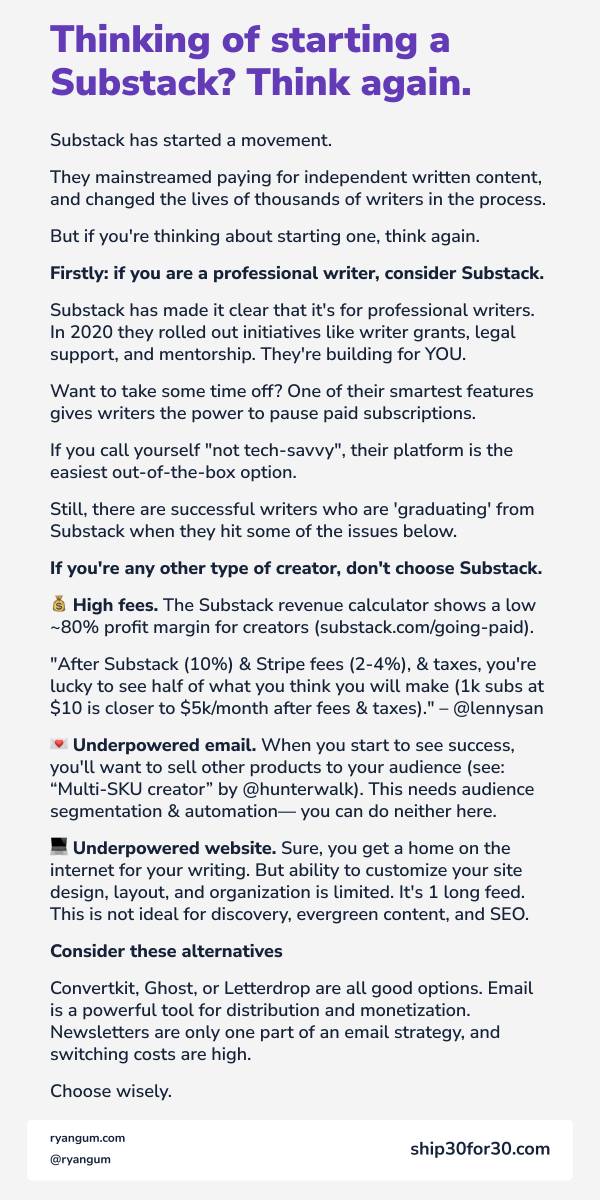
📖 Creator economy reading list
As we kick off 2021, here's a roundup of my favorite Creator Economy / Passion Economy reads from 2020, covering:
• State of the market
• State of creators
• Trends and insights
• Platform strategy
👇
As we kick off 2021, here's a roundup of my favorite Creator Economy / Passion Economy reads from 2020, covering:
• State of the market
• State of creators
• Trends and insights
• Platform strategy
👇
How many creators are there? Who are the key players? What are the key trends? If you're looking for an overview of the creator economy, this is a great place to start.
signalfire.com/blog/creator-e… by @YuanlingY, @JoshConstine
signalfire.com/blog/creator-e… by @YuanlingY, @JoshConstine
A different take on the creator economy map, but equally as interesting. This map categorizes 150+ companies by creator lifecycle: content creation, audience growth and ownership, monetization, and biz ops.
hugo.pm/mapping-the-cr… by @HugoAmsellem
hugo.pm/mapping-the-cr… by @HugoAmsellem
How do creators build wealth?
• Promote other people's products
• Sell their own products
• Invest
thegeneralist.substack.com/p/audience-and… by @mariodgabriele
• Promote other people's products
• Sell their own products
• Invest
thegeneralist.substack.com/p/audience-and… by @mariodgabriele
What do creators sell?
• Sharing profits w/ an audience
• Borrowing from Reddit
• The @MrBeastYT Flywheel
thegeneralist.substack.com/p/audience-and… by @mariodgabriele
• Sharing profits w/ an audience
• Borrowing from Reddit
• The @MrBeastYT Flywheel
thegeneralist.substack.com/p/audience-and… by @mariodgabriele
Creators have a hierarchy of needs that follow a rough priority order from creation through to monetization.
It's hard to build an audience without finding a good niche, and it's hard to make money if you haven't built an audience.
peteryang.substack.com/p/creator-hier… by @petergyang
It's hard to build an audience without finding a good niche, and it's hard to make money if you haven't built an audience.
peteryang.substack.com/p/creator-hier… by @petergyang
In 2008, @kevin2kelly proposed that the internet would enable creatives to skip the middlemen and make a good living by engaging and monetizing fans directly.
Today, creators can make the same amount of money from even fewer fans.
a16z.com/2020/02/06/100… by @ljin18
Today, creators can make the same amount of money from even fewer fans.
a16z.com/2020/02/06/100… by @ljin18
Just like millionaires have an average of 7 income streams, the most successful creators have multiple revenue streams.
Enter, the Multi-SKU Creator.
hunterwalk.com/2020/12/01/why… by @hunterwalk
Enter, the Multi-SKU Creator.
hunterwalk.com/2020/12/01/why… by @hunterwalk
With more creators, content, and choice than ever before, consumers are in a state of analysis paralysis.
The real scarcity isn’t content. It’s attention.
As the amount of content grows, so does the market for credible curators.
gabygoldberg.medium.com/curators-are-t… by @gaby_goldberg
The real scarcity isn’t content. It’s attention.
As the amount of content grows, so does the market for credible curators.
gabygoldberg.medium.com/curators-are-t… by @gaby_goldberg
3 broad trends driving the future of creators:
1. Everyone can be creators
2. They have direct, authentic connections to communities
3. Creators have new tools to monetize their work
(Use "influencer" and "creator" interchangeably here)
digitalnative.substack.com/p/onlyfans-and… by @rex_woodbury
1. Everyone can be creators
2. They have direct, authentic connections to communities
3. Creators have new tools to monetize their work
(Use "influencer" and "creator" interchangeably here)
digitalnative.substack.com/p/onlyfans-and… by @rex_woodbury
Peter outlines 8 creator platform models that are universal. A must-read for both creators and the creator economy industry.
peteryang.substack.com/p/lessons-abou… by @petergyang
peteryang.substack.com/p/lessons-abou… by @petergyang
If you’re a startup building a platform for creators, here are the key metrics you'll want to track across success, revenue, engagement, growth, and community.
a16z.com/2020/01/08/key… by @ljin18
a16z.com/2020/01/08/key… by @ljin18
It’s a common belief that in online communities, 90% of users are consumers/lurkers, 9% are contributors, and 1% are creators. This is often called the 90-9-1 rule.
This study found that this ratio may no longer be true.
higherlogic.com/blog/90-9-1-ru… by @HigherLogic
This study found that this ratio may no longer be true.
higherlogic.com/blog/90-9-1-ru… by @HigherLogic
Super Fan: someone who wants authentic interactions with a creator, and is willing to pay a lot for them.
Startups can grow by helping creators make money through authentic interactions with super fans.
peteryang.substack.com/p/the-super-fa… by @petergyang
Startups can grow by helping creators make money through authentic interactions with super fans.
peteryang.substack.com/p/the-super-fa… by @petergyang
The creative economy looks a lot like the U.S. economy — there are a few big winners and a lot of people hustling to make a living and barely getting by.
Here are 10 strategies for fostering the creator middle class.
hbr.org/2020/12/the-cr…, li.substack.com/p/building-the… by @ljin18
Here are 10 strategies for fostering the creator middle class.
hbr.org/2020/12/the-cr…, li.substack.com/p/building-the… by @ljin18
An insightful response to Li's article above from a self-confessed middle class creator:
• The value of a shoutout from a large account
• Attention to capital conversion efficiency
• Creator monetization strategy
joma.substack.com/p/creators-per… by @jomaoppa
• The value of a shoutout from a large account
• Attention to capital conversion efficiency
• Creator monetization strategy
joma.substack.com/p/creators-per… by @jomaoppa
2020 was a breakout year for the creator economy
• Substack has 250k+ paid subs
• Patreon is now valued at $1.2B
• OnlyFans earned $300M in profit
• Cameo handled $100M transactions
• Twitch 2X'd the number of streamers
axios.com/creators-incom… by @sarafischer
• Substack has 250k+ paid subs
• Patreon is now valued at $1.2B
• OnlyFans earned $300M in profit
• Cameo handled $100M transactions
• Twitch 2X'd the number of streamers
axios.com/creators-incom… by @sarafischer
What am I missing?
If you enjoyed this thread and want to learn more about the Creator Economy space...
Follow me @ryangum and subscribe to my upcoming posts for more insights:
ryangum.com
Follow me @ryangum and subscribe to my upcoming posts for more insights:
ryangum.com
• • •
Missing some Tweet in this thread? You can try to
force a refresh




